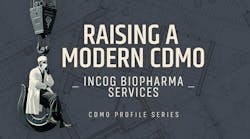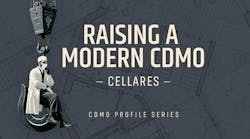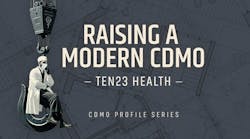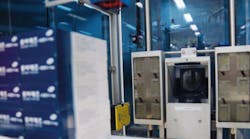PhM: How is your facility set up so as to maintain separation between highly active and other compounds in production?
J.C.: We conduct our safety assessment at the inception of each project. If the compound is deemed highly potent, that is to say that the operator exposure limit (OEL) is determined to be less than one micron per cubic meter of breathing zone air, all processing operations are conducted in a discrete GMP facility, designed to contain the compound down to 30 nanograms per cubic meter of room air in the breathing zone. This facility features totally independent access and egress, a dedicated one-pass air handler, multiple air pressure cascades, and is fitted with a unique system of isolators to ensure containment.
PhM: What’s your organizational strategy for separation? In other words, what aspects of the organization are devoted solely to potent compounds, and what aspects overlap between potent and non-potent?
J.C.: When Metrics made the commitment to fully segregate and contain highly potent compounds and to dedicate equipment to the new facility it was decided that the safest and most efficient way to utilize this capacity was to organize a dedicated team to work within the new area. The group of scientists and specialists that handle these compounds are specially trained in addition to the curriculum normally required to work in a GMP environment. We have specialized conveyance equipment and specialized procedures that govern the movement of these compounds to, from, and within the facility. When these operations are more focused we are able to attain better work-practice as a result of their routine experience.
Another benefit is that we are able to keep access to the area at a bare minimum. It makes for a tighter operation. However, we are integrated cross-departmentally with supporting groups such as QA, EHS, and Analytical. We haven’t seen the need to fully dedicate groups within these departments, although that remains a possibility as our services expand.
PhM: What are your main responsibilities in your role as director of potent pharmaceutical development, and how do you fit into the company’s overall organizational structure?
J.C.: I report to the Vice President of Pharmaceutical Development, Dr. Mike Ruff. My team focuses on the development and phase 1-3 clinical supplies’ manufacture of dosage forms containing highly potent compounds. We operate similarly to the two lateral groups within the department except we occupy the dedicated facility and employ the hard wall containment technologies. In addition to my project management, technical, and general managerial roles, I am responsible for the conceptualization and procurement of the technologies that allow us to contain highly potent compounds across a broad spectrum of process-types while remaining highly responsive to our customers. I also serve on the safety assessment team for new compounds.
PhM: Are your job responsibilities different from what you’ve seen at other companies?
J.C.: Yes. Launching and operating this new capacity at Metrics has been very rewarding. Years ago those of us in formulation development saw a clear trend in the rising ratio of projects involving highly potent compounds. Simultaneously we saw a strong evolution of the Industrial Hygiene discipline. The vernacular with regard to control banding, etc. seemed to become a bit more standardized across the industry. So as a company we recognized that we had to understand this landscape and then offer a best-practice service in our field.
The senior management team also appreciated that those ultimately working with isolation technology would need to be intimately involved with the design of the entire operation for it to be adopted successfully. Rolling out the capacity was framed as a challenge and an opportunity for the development scientists rather than a burdensome necessity imposed by EH&S or Industrial Hygiene groups. So they chose me, a formulation development scientist, to manage the addition of the capacity rather than a project engineer.
In my previous experiences, engineering groups generally led construction projects and the end-users supported by communicating their needs. But with this project I was able identify the footprint within the building to be renovated, sketched the layout, and conceptualized and designed a unique system of interlocking isolators. It involved daily meetings with the engineering disciplines, safety, the general contractor, and the equipment vendors. Fortunately we had very talented collaborators who got comfortable with this arrangement as I learned their language. And even though I manage day-to-day operations of the now-operational facility, I am still responsible for identifying and designing technologies and capacities to support our growth. It’s a larger role than that of a manager of pharmaceutical scientists but it has been a wonderful experience.
PhM: Did you develop staff expertise in-house for handling highly active ingredients, or did you hire external expertise? A little of both?
J.C.: It was a lot of both. From our involvement with ISPE’s community of practice we understood right away that there are about as many ways to tackle this issue as there are companies in the business. We looked at everything. Local ventilation and laminar/down-flow technologies have many benefits and really offer a lot of comfort and versatility but are very dependent on work-practice. Similarly, flexible containment solutions are very practical and achieve very good containment performance but concerned us from a cleaning standpoint, or if disposable, a cost of goods standpoint.
After we made the policy decision to adopt hard wall isolation and buy brand new equipment we designed the unique interlocking isolation system. So by looking outside we got a sense of best practice and then applied it at Metrics. We felt it was important for a third-party industrial hygiene consultancy firm to work with our EH&S group to conduct all of the containment challenges. It imparted more objectivity when we assessed the performance of the equipment. The whole process forced us to become experts. As you might imagine, we are still in the process of refining our procedures.
PhM: Are you responsible for developing practices that conform with FDA’s Quality by Design initiative (eg, risk management, Quality Systems, etc.), or is that something that is guided mainly by client preferences or another group at Metrics?
J.C.: Yes we currently practice QbD concepts and apply ICH Q8 Rev. 1, Q9 and Q10 guidelines for pharmaceutical development risk management. But it’s also common that we collaborate with the client and other partners and don’t assume complete control of the development process. While as a CRO we have a good deal of influence over activities at a given phase of development we make an effort to both understand and occupy the role a client wishes for us to assume. This can be a leadership role or a supporting role.
PhM: Quality Systems is an area with obvious overlap between potent and non-potent areas, but are there some aspects of your QS approach that are unique to the cytotoxic facility? If so, how are these aspects handled?
J.C.: The primary QS that is tailored to the new area and different from other areas is the cleaning verification policy. We devised a new procedure that requires HPLC recovery of the API below a residual threshold after every batch or campaign of batches, regardless of what a subsequent activity may be. We don’t subscribe to a cleaning validation program in the new area because once you have a validated cleaning procedure you rely on operator technique and conformance to the procedure. Instead we perform chemical verification every time an active is removed from equipment. This way we have proof that every active is removed properly after every processing event. We also implemented a health-based system of determining what our acceptable residual threshold will be. It’s very conservative with many safety factors.
PhM: The isolator system that you’ve incorporated into the new facility features docking ports, so that different pieces of equipment can be installed, in different order, to cater to clients’ various processes. How did this idea evolve, and how did you work with vendors and suppliers to make it a reality?
J.C.: We’re very proud of the system. When we looked at the process-types that we would need to offer we realized we wouldn’t have the space to house each piece of equipment in its own customized isolator. We also didn’t want anything that was as unsophisticated as merely placing equipment in a box. That wouldn’t provide for good ergonomics and we’d wind up contaminating mechanical and electrical (non-process surfaces) of the equipment. So we started thinking about a baffle or plate that would separate these areas of the equipment early on. It was absolutely essential that we could construct a wide range of equipment trains in any order necessary.
So the idea of a standardized docking port was born. We sketched out how an approximately three-square-foot steel plate could be installed on a variety of pieces of equipment separating processing and non-processing areas of equipment. Then, since the periphery of the plate was standardized, it would be able to mate with one of three docking locations on one of three isolators within the facility. The trick was ensuring that each piece of processing equipment penetrated each plate in a manner that placed the processing surfaces of the equipment in an ergonomically viable space within the isolator.
We also wanted to be able to accommodate long process trains. I envisioned a process that included milling, screening, granulating, fluid bed drying, sizing, blending, compressing, and film coating. So that is eight processes. I wanted to be able to put this together in a single room at the same time. We had seen some plate/baffle isolator designs offered by Getinge and approached them about this system. After a lot of very constructive discussion we came up with the drawings. We were also inclined to use familiar brands of processing equipment to integrate with the docking plate so our clients wouldn’t think this was some experimental or esoteric system that might give them pause. Rounding up the processing equipment and ensuring it would work through the plate was a challenge.
PhM: What were the design and implementation challenges of the docking system? What were the biggest headaches along the way?
J.C.: Getting all of the processing equipment (the mills, blenders, granulators, and the roller compactor) sent to Getinge in Minnesota and then building a full-scale mock-up was quite a project. We spent days working on making sure each piece of equipment would be perfectly positioned within the isolator when installed so nothing was out of reach. There is simply no substitute for building the mock-up.
PhM: What is the range of equipment that now conforms to the docking ports? How did you standardize key pieces of processing equipment to conform to a given docking window?
J.C.: As long as we can penetrate a vertical three-square-foot plate with the product contact surfaces of a piece of equipment we are likely to get it to work. So we have a conical mill, an impact mill, a jet mill, high shear granulators (1-,2-,4- and 8-liter), a roller compactor, and V blenders (0.5-, 1-, 2-, 4-, 8-, and 16-qt) that work through the system. We also can install blank plates without equipment and use the interior of the isolator for a benchtop area for screening, weighing, or for in-process instruments.
PhM: What are the limitations of the system? Are there certain pieces of equipment that can’t be configured to the ports, or are there aspects of a hardwall system that limit your flexibility?
J.C.: The limitations mostly have to do with size. We knew that certain pieces of equipment could not work through a vertical plate. We have separate isolators integrated with our tablet press and fluid bed unit. The system generally limits us to maximum batch sizes of 7 to 10 kg depending on bulk density.
PhM: What is your current production output in the new facility, and what is your capacity? Do you have plans to expand for larger scale manufacturing?
J.C.: We are primarily a GMP laboratory focused on developing solid-oral dosage forms and then providing the clinical supplies. In most instances the volume for these highly potent products is relatively low so are confident we can sustain a project through the entire development process. We are operational and manufacturing clinical batches routinely but are also actively marketing the capacity. The response so far has been great. Furthermore we are considering some low-volume commercial production that requires isolation technology. We have already specified some equipment that will take our maximum scale to about 30 kg. Beyond that we would need to build another facility – which is another project I am really looking forward to.





